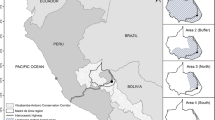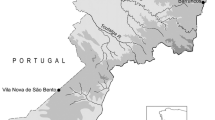Abstract
Rapid deforestation has occurred in northern Thailand over the last few decades and it is expected to continue. The government has implemented conservation policies aimed at maintaining forest cover of 50% or more and promoting agribusiness, forestry, and tourism development in the region. The goal of this paper was to analyze the likely effects of various directions of development on the region. Specific objectives were (1) to forecast land-use change and land-use patterns across the region based on three scenarios, (2) to analyze the consequences for biodiversity, and (3) to identify areas most susceptible to future deforestation and high biodiversity loss. The study combined a dynamic land-use change model (Dyna-CLUE) with a model for biodiversity assessment (GLOBIO3). The Dyna-CLUE model was used to determine the spatial patterns of land-use change for the three scenarios. The methodology developed for the Global Biodiversity Assessment Model framework (GLOBIO 3) was used to estimate biodiversity intactness expressed as the remaining relative mean species abundance (MSA) of the original species relative to their abundance in the primary vegetation. The results revealed that forest cover in 2050 would mainly persist in the west and upper north of the region, which is rugged and not easily accessible. In contrast, the highest deforestation was expected to occur in the lower north. MSA values decreased from 0.52 in 2002 to 0.45, 0.46, and 0.48, respectively, for the three scenarios in 2050. In addition, the estimated area with a high threat to biodiversity (an MSA decrease >0.5) derived from the simulated land-use maps in 2050 was approximately 2.8% of the region for the trend scenario. In contrast, the high-threat areas covered 1.6 and 0.3% of the region for the integrated-management and conservation-oriented scenarios, respectively. Based on the model outcomes, conservation measures were recommended to minimize the impacts of deforestation on biodiversity. The model results indicated that only establishing a fixed percentage of forest was not efficient in conserving biodiversity. Measures aimed at the conservation of locations with high biodiversity values, limited fragmentation, and careful consideration of road expansion in pristine forest areas may be more efficient to achieve biodiversity conservation.




Similar content being viewed by others
References
Alkemade R, van Oorschot M, Nellemann C, Miles L, Bakkenes M, Brink Bten (2009) GLOBIO3: a framework to investigate options for reducing global terrestrial biodiversity loss. Ecosystems 12(3):349–359
Allen CR, Pearlstine LG, Kitchens WM (2001) Modeling viable populations in gap analysis. Biological Conservation 99(2):135–144
Barnaud C, Promburom P, Bousquet F, Trébuil G (2006) Companion modelling to facilitate collective land management by Akha villagers in upper northern Thailand. Journal of the World Association Soil & Water Conservation 1(4):38–54
Castella JC, Verburg PH (2007) Combination of process-oriented and pattern-oriented models of land use change in a mountain area of Vietnam. Ecological Modelling 202(3–4):410–420
CFAN (Forestry Advisers Network) (2005) Deforestation: tropical forests in decline. CIDA Forestry Advisers Network. http://www.rcfa-cfan.org/english/issues.12-3.html. Accessed 12 Feb 2008
Charuphat T (2000) Remote sensing and GIS for tropical forest management. In: GIS Application Center (ed) Proceedings of the Ninth Regional Seminar on Earth Observation for Tropical Ecosystem Management, Khao Yai, Thailand, 20–24 November 2000. National Space Development Agency of Japan, Remote Sensing Technology Center of Japan, Royal Forest Department, and GIS Application Center/AIT, Khao Yai National Park, Thailand, pp 42–49
Cropper M, Griffiths C, Mani M (1996) Roads, population pressures and deforestation in Thailand, 1976–1989. World Bank, New York
Delang CO (2002) Deforestation in northern Thailand: the result of Hmong farming practices or Thai development strategies? Society and Natural Resources 15:483–501
Delin AE, Andren H (2004) Effects of habitat fragmentation on Eurasian red squired (Sciurus vulgaris) in a forest landscape. Landscape Ecology 14:62–72
Department of Local Administration (2007) Population census in Thailand from 1994 to 2007. http://www.dopa.go.th/hpstat9/people2.htm. Accessed 2 Mar 2008
Dobson AP (1996) Conservation and biodiversity. Scientific American Library, New York
Food and Agriculture Organization of the United Nations (2005) Global forest assessment. Food and Agriculture Organization of the United Nations. http://www.fao.org/forestry/site/fra/24690/en. Accessed 3 Mar 2008
Forman RTT (1995) Land Mosaics: the ecology of landscapes and regions. Cambridge University Press, Cambridge, UK
Fox J, Vogler JB (2005) Land-use and land-cover change in montane mainland Southeast Asia. Environmental Management 36(3):394–403
Fukushima M, Kanzaki M, Hara M, Ohkubo T, Preechapanya P, Chocharoen C (2008) Secondary forest succession after the cessation of swidden cultivation in the montane forest area in northern Thailand. Forest Ecology and Management 255(5–6):1994–2006
Gotelli NJ (2001) A primer of ecology. Sinauer Associates, Sunderland, MA
Lambin EF, Geist J, Lepers E (2003) Dynamics of land-use and land-cover change in tropical regions. Annual Review in Environment and Resources 28:205–241
Land Development Department (2001) Soil erosion map. Land Development Department, Ministry of Agriculture and Co-operatives, Bangkok, Thailand
Land Development Department (2003) Annual statistics report year 2003. Land Development Department, Ministry of Agriculture and Co-operatives, Bangkok
Lomolino MV (1982) Species-area and species-distance relationships of terrestrial mammals in the Thousand Island Region. Journal Oecologia 54:72–75
MacDonald G (2003) Biogeography: introduction to space, time and life. John Wiley & Sons, New York
Matthews R, Gilbert N, Roach A, Polhill JG, Gotts NM (2007) Agent-based land-use models: a review of applications. Landscape Ecology 22(10):1447–1459
McGarigal K, Marks B (1995) FRAGSTATS: spatial pattern analysis program for quantifying landscape structure. Gen. Tech. Rep. PNW-GTR-351, Portland, OR
Oberhauser U (1997) Secondary forest regeneration beneath pine (Pinus kesiya) plantations in the northern Thai highlands: a chronosequence study. Forest Ecology and Management 99(1–2):171–183
Office of Agricultural Economics (2007) Agricultural statistics of Thailand 2004. Ministry of Agriculture and Co-operatives, Bangkok
Office of Environmental Policy and Planning (1997) Thailand policy and perspective plan for enhancement and conservation of national environmental quality, 1997–2016. Ministry of Science, Technology and Environment, Bangkok
Office of Natural Resources, Environmental Policy and Planning (2006) The state of the environment for the year 2005–2006. Office of Natural Resource and Environmental Policy and Planning, Ministry of Natural Resources and Environment, Bangkok
Overmars KP, Verburg PH, Veldkamp T (2007) Comparison of a deductive and an inductive approach to specify land suitability in a spatially explicit land-use model. Land Use Policy 24(3):584–599
Panayotou T, Sungsuwan S (1989) An economic study of the causes of tropical deforestation: the case of northeast Thailand. Development Discussion Paper No. 284. Harvard University Institute of Economic Development, Cambridge, MA
Pattanavibool A, Dearden P, Kutintara U (2004) Habitat fragmentation in north Thailand: a case study. Bird Conservation International 14:S13–S22
Pontius R, Boersma W, Castella J-C, Clarke K, de Nijs T, Dietzel C, Duan Z, Fotsing E, Goldstein N, Kok K, Koomen E, Lippitt C, McConnell W, Mohd Sood A, Pijanowski B, Pithadia S, Sweeney S, Trung T, Veldkamp A, Verburg P (2008) Comparing the input, output, and validation maps for several models of land change. Annals of Regional Science 42:11–37
Priess JA, Schaldach R (2008) Integrated models of the land system: a review of modelling approaches on the regional to global scale. Living Reviews in Landscape Research 2. http://www.livingreviews.org/lrlr-2008-1. Accessed 4 Apr 2009
Rajan KS, Shibasaki R (1997) Estimation of agricultural productivity and its application to modelling the expansion of agricultural land in Thailand. Journal of Agricultural Meteorology 52(5):815–818
Redford KH, Richter BD (1999) Conservation of biodiversity in a world of use. Conservation Biology 13(6):1246–1256
Royal Forest Department (2007) Forestry statistics year 2006. Ministry of Natural Resources and Environment, Bangkok
Royal Thai Survey Department (2002) Topographic map scale 1:50, 000. Ministry of Defense, Bangkok
Santisuk T (1988) An account of the vegetation of northern Thailand. Geological Research 5. Franz Steiner Verlag, Stuttgart
Schmidt-Vogt D (1999) Swidden farming and fallow vegetation in northern Thailand. Geological Research 8. Franz Steiner Verlag, Stuttgart
Scholes RJ, Biggs R (2005) A biodiversity intactness index. Nature 434:45–49
Stracey CM, Pimm SL (2009) Testing island biogeography theory with visitation rates of birds to British islands. Journal of Biogeography 36:1532–1539
Swets JA (1986) Measuring the accuracy of diagnostic systems. Science 240:1285–1293
Thanapakpawin P, Richey J, Thomas D, Rodda S, Campbell B, Logsdon M (2006) Effects of land-use change on the hydrologic regimes of the Mae Chaem river basin, NW Thailand. Journal of Hydrology 334(1–2):215–230
Theobald DM (2005) GIS concepts and ArcGIS methods, 2nd edn. Colorado State University, Ft. Collins
Trisurat Y (1999) Land-use changes inside and around Srinakharin and Erawan National Parks: final report submitted to the Royal Forest Department. Environ Planning, Bangkok
Trisurat Y (2007) Applying gap analysis and a comparison index to assess protected areas in Thailand. Environmental Management 39(2):235–245
United Nations Environmental Programme (2001) GLOBIO: global methodology for mapping human impacts on the biosphere. Report UNEP/DEWA/TR 25. United Nations Environmental Programme, Nairobi
Verburg PH, Overmars K (2009) Combining top-down and bottom-up dynamics in land use modeling: exploring the future of abandoned farmlands in Europe with the Dyna-CLUE model. Landscape Ecology 24:1167–1181
Verburg PH, Veldkamp A (2004) Projecting land use transitions at forest fringes in the Philippines at two spatial scales. Landscape Ecology 19(1):77–98
Verburg PH, Soepboer W, Limpiada R, Espaldon MVO, Sharifa M, Veldkamp A (2002) Land-use change modelling at the regional scale: the CLUE-S model. Environmental Management 30(3):391–405
Verburg PH, Schot P, Dijst MJ, Veldkamp A (2004) Land use change modelling: current practice and research priorities. GeoJournal 61(4):309–324
Verburg PH, Eickhout B, van Meijl H (2008) A multi-scale, multi-model approach for analyzing the future dynamics of European land use. Annals of Regional Science 42:57–77
Watcharakitti S (1976) Tropical forest land-use evolution in northern Thailand. Forest Research Bulletin No. 44. Faculty of Forestry, Kasetsart University, Bangkok
Acknowledgments
The authors would like to thank the Kasetsart University Research and Development Institute (KURDI) and The Netherlands Environmental Assessment Agency (PBL) for financial support for this research project. In addition, gratitude is expressed to the Royal Forest Department, Department of National Park, Wildlife and Plant Conservation, and Land Development Department for providing information. Nipon Tangtham, the handling editor, and two anonymous reviewers provided valuable suggestions and comments during preparation of the manuscript.
Author information
Authors and Affiliations
Corresponding author
Rights and permissions
About this article
Cite this article
Trisurat, Y., Alkemade, R. & Verburg, P.H. Projecting Land-Use Change and Its Consequences for Biodiversity in Northern Thailand. Environmental Management 45, 626–639 (2010). https://doi.org/10.1007/s00267-010-9438-x
Received:
Accepted:
Published:
Issue Date:
DOI: https://doi.org/10.1007/s00267-010-9438-x




